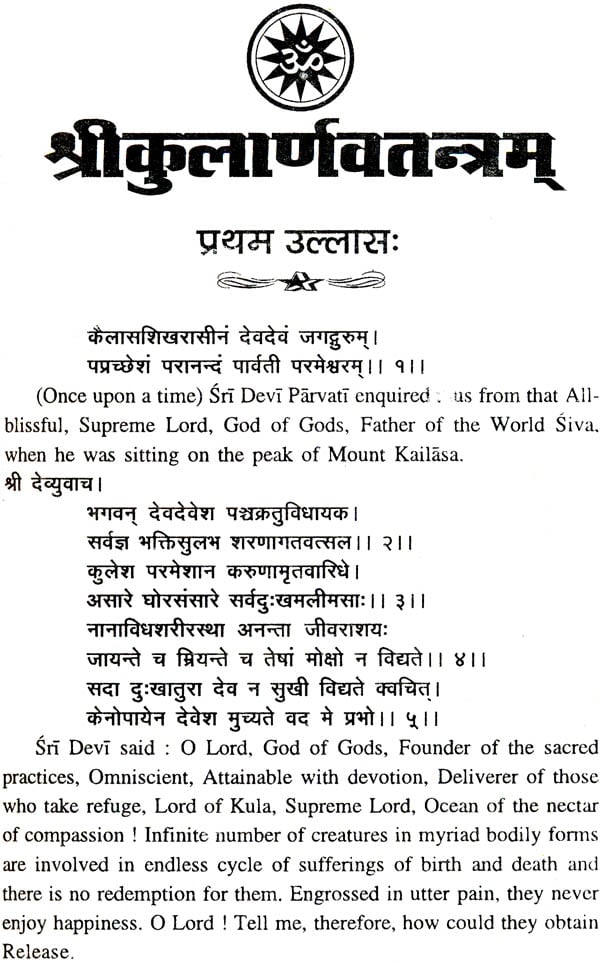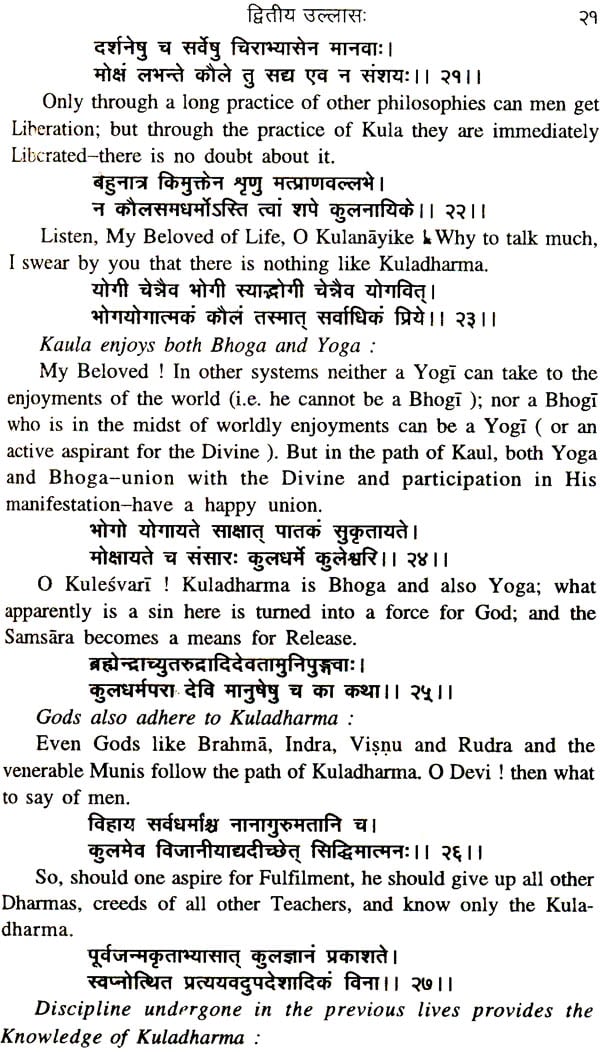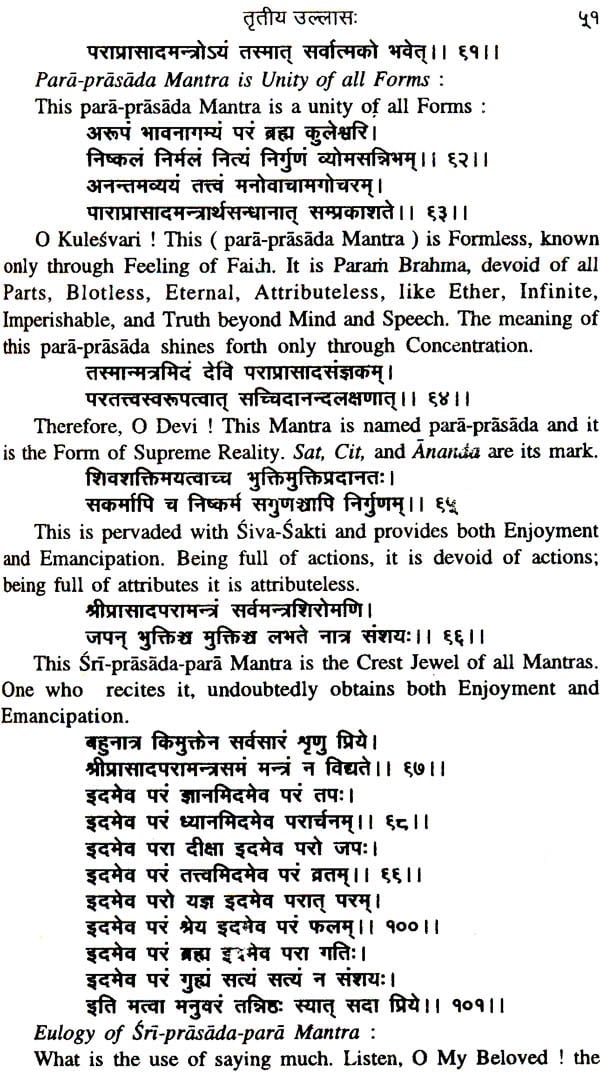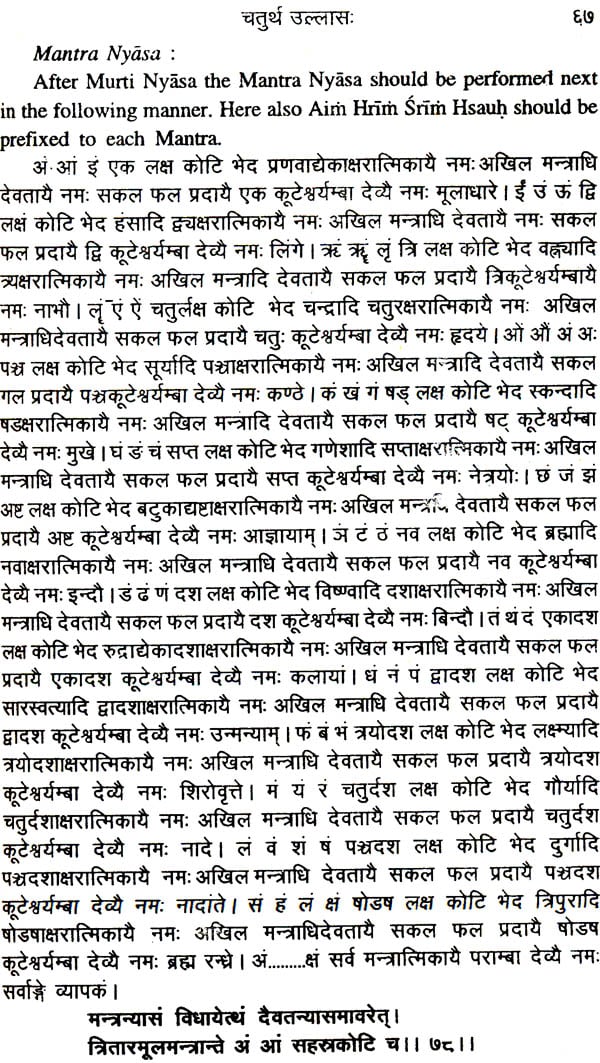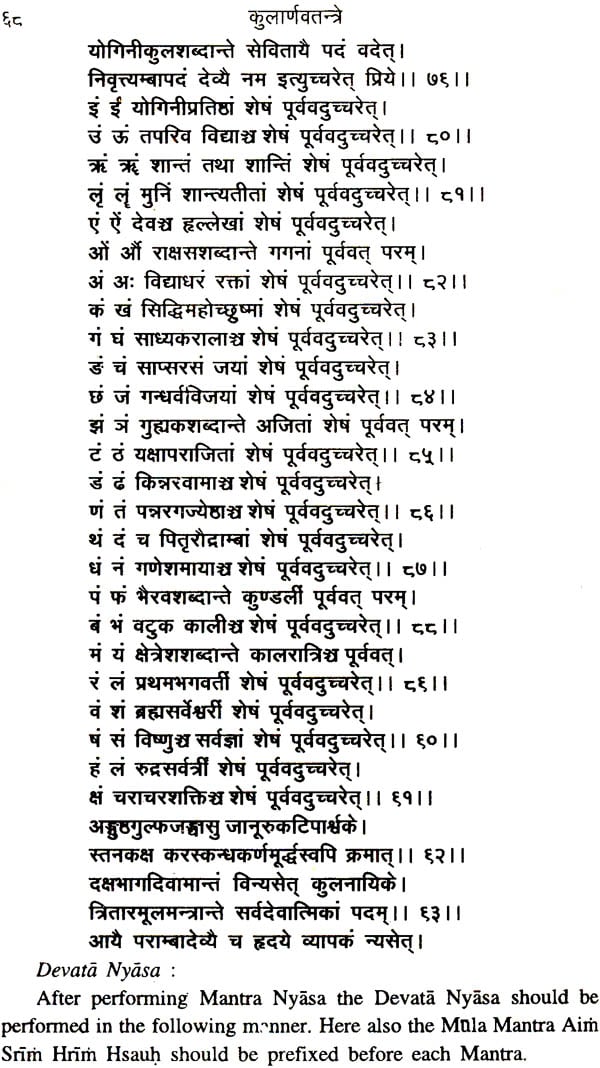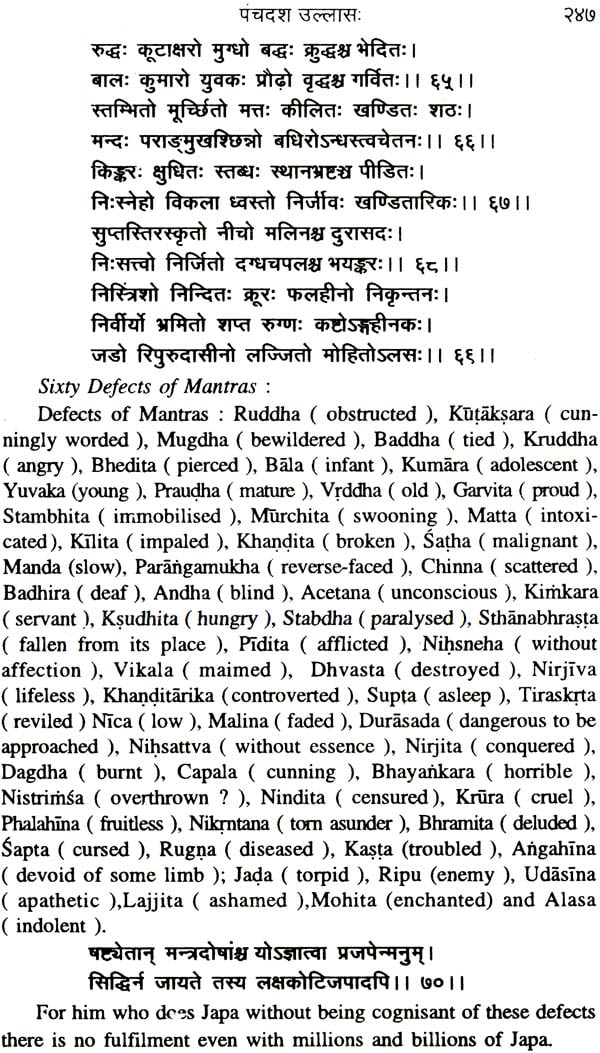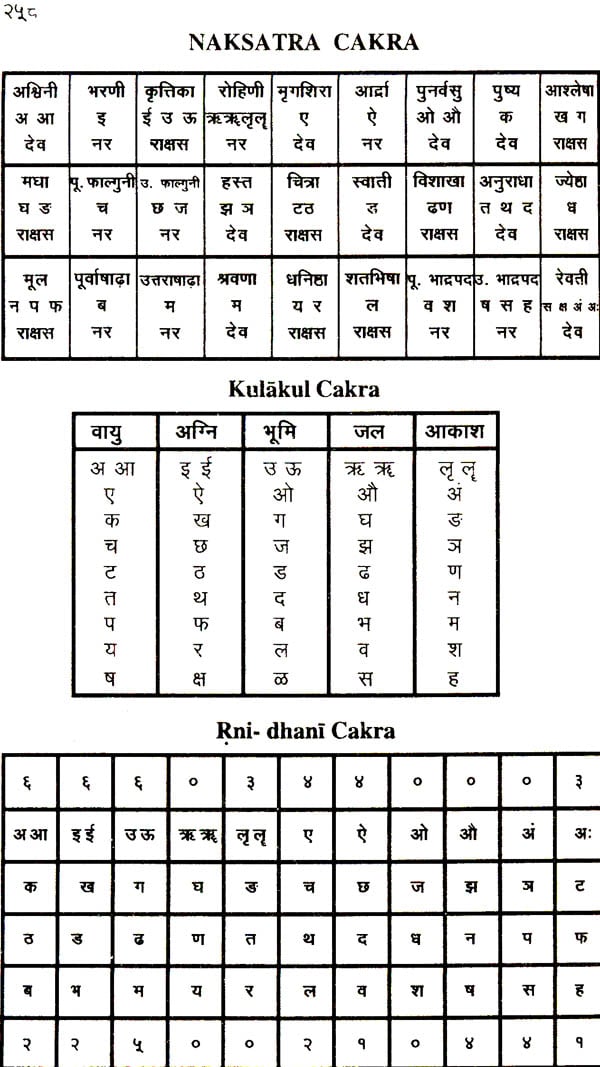
Kularnava Tantra
Book Specification
| Item Code: | IDI580 |
| Author: | Ram Kumar Rai |
| Publisher: | Prachya Prakashan, Varanasi |
| Language: | Sanskrit Text with English Translation |
| Edition: | 2010 |
| Pages: | 277 |
| Cover: | Hardcover |
| Other Details | 8.6" X 5.3" |
| Weight | 390 gm |
Book Description
Kularnava is one of the major Tantra of the Kaula School. It commands great authenticity, authority and respect. It has been profusely quoted by almost all the later Tantric works. However, its language, as is the case with most of the other Tantras, mostly conveys information in a codified form not easily discernible by everyone. The purpose behind such a use is to keep the secrets of the teachings confined only to the Sadhakas initiated in the system. Therefore, as the work stands, it cannot be understood easily by ordinary readers. Perhaps for this reason Sir Arthur Avalon also wanted to publish a Translation of this Text. However, he could not find time to do so and the work has been completed by an ordinary student as myself. Mr. M. P. pandit has published a very erudite study of this Tantra in English but it can in no way be regarded as a verbatim translation. Moreover, he has left many Ullasas even in his commentary.
When I undertook the work of this translation, I never thought it to be so difficult. As I proceeded, I found that at places the information is highly codified and at others, I Was at my wits end. No Dictionary, either modern or classical can be useful in the interpretation of such passages. Consequently, I had to go through a large number to Tantras, besides discussion the matter with some of the orthodox Tantrics.
Now, as the work has been completed, I can say that almost all the information has been decodified and Translated according to my capacity. The Mantras, various Nyasas and other Ritualistic details have been translated and explained. However, as the long Mantras of Nyasa and some of the bigger Mantras would have been cumbersome in Roman, I have chosen to give them in Devanagari script. Sadhakas and these Sadhakas may well be familiar with the Nagari script. Apart from this all other passages have been invariably translated. However, I hope that the Sadhakas would, in the script of the instructions of Lord Siva, maintain the secrecy of the Mantras and other rituals.
For the purpose of this Translation althought, I have followed the Text constituted by Sir Arthur Avalon, yet at places, I have adopted some of the variant readings as the main readings because they made better sense. Such changes have been made at many places.
I take this opportunity to express my gratitude to some of my Tantric friends, who want to remain anonymous, for the help they so readily gave to me in the interpretation of the typical passages.
I would also like to express my gratitude to Mr. M. P. Pandit whose brilliant study of Kularnava has been of great help to me. Wherever I have found his sentences as translation of the Text, I have adopted them, making changes only to bring them literally closer to Text.
With all its faults and failings the work is now in the hand of the readers and I hope they would be kind enough to enlighten me with my shortcomings so that I may make amends in the future editions.
| (Pages 1 - 17) |
| Forms of Siva Characteristics of Creatures and their conditions 2; Four kinds of Creatures 2; Superiority of human body 3, Preservation of the body 3, Perishability of Gods like Brahma etc. 7, Causes of the decrease in life-span 7, Fruit of actions of one life reaped in another 8, Sufferings due to one's own sins 8, Non-attachment is liberation 8, Evils of world 9, Without discriminative knowledge there is no liberation even through emaciation o the body 11, Fruits of ritualistic practices alone 12, No liberation from the study of the Sastras alone without spiritual knowledge 13, Truth inherent in the-Self 14, Liberation only through Real Knowledge 15, Guru's instructions alone gives liberation 15, Two kind of knowledge : Spiritual and Mental Reasoning 16, No spiritual knowledge without control of senses and kindness of Guru 16. |
| (Pages 18 - 43) |
| Superiority of Kula-dharma 19, Order of Superiority 19, Kaula enjoys both Bhoga and yoga 21, Gods also adhere to kula-dharma 21, Discipline undergone in the previous lives provides knowledge of kela-dharma 21, Knowledge of kula-dharma dawns upon a mind purified by Mantra and Japa 22, Eligibility for knowledge 22, Sins of communicating the kula-dharma to the underserving 23, Glory of kula-dharma 23, Worship of kula (Saktidevi) provides the blissful state 25, Ignorant of kula-dharma lives like animals 27, Only he is a man who follows kula-dharma 27, Scholars of Veda but ignorant of kula are inferior even to Candalas 27, Worshipper of Sakti alone is a true Kula 27, six systems of philosophies are Sivas limbs and the Veda-sastras are full of kula-dharma 30, Authenticity of kula-sastra inherent in its providing immediate fruit 30, Knowledge of kula is not for sinners 31, Pasu-sastras propagated to beguile the evil-minded 31, The plight of kula-dharma in the hands of people with false knowledge 32, Drinking denounced by the Vedas 34, Eleven kinds of wine prohibited for the Dvijas 35, Penance on sighting etc. of wine 35, Penance for meaningless killing 35, Eight kinds of animal-killers 36, Three kinds of slaughter 36, The five M's should he resorted to only in the prescribed manner 36, Vedic proof in favour of kula-dharma 36. |
| (Pages 38 - 54) |
| Urdhvamnaya is Purna-Brahman 38, Origin of five Amnayas from the Faces of Siva 39, Superiority of Urdhvamnaya 39, Origin of the Amnayas from the portions of Gods, Sakti and Siva 39, Fruits of the knowledge of Amnayas 40, meaning of Urdhvamnaya 40, Superiority of Urdhvamnayas proved through example 40, Basis of the knowledge of Urdhvamnaya 41, Urdhvamnaya can be known only from the month of the Guru 42, Knower of Urdhvamnaya is blessed and librated from his worldly life 42, Eulogy of the knower of Urdhvamnaya 43, Distinction of amnayas based on creation etc. 44, Distinction of amnayas on the basis of the number of principles 44, In Urdhavamnaya there is absence of all the above 44, Glory of the Sri-prasada-para Mantra in the form of Siva-Sakti 44, The whole world is inherent in this Prasada Mantra 45, Mantras without the accompaniment of Para-Parasada are ineffective 46, Even the God and sages also recite Prasada-para Mantra 47, Man of the lowest class, if knows the Para-prasada Mantra can install the idol of a Devata 48, Knower of the Para-prasada Mantra has the knowledge of all the Saiva, etc. Mantras 49, Para-prasada Mantra is bestower of all fruits 49, Saci-Indra, etc. duals are all Forms of Sakti-prasada-para Mantra 51, Method of recitation of Sri-prasada-para Mantra 52, Sri-prasada-para Mantra provides both enjoyment and emanciption 53. |
| (Pages 55 - 74) |
| Extrication of the Sri-prasada-para Mantra 55, Wordmeaning of Prasada Mantra 56, Delineation of duties prior to Nyasa 56, Rsyadi-nyasa of Sri-para-prasada Mantra 57, Alpa-sodha-nyasa 58, Maha-sodha-nyasa 60, Prapanca-nyasa 60, Bhuvana-nyasa 63, Mantra Nyasa 67, Devata Nyasa 68, Matrka Nyasa 70, Ardha-Narisvara Dhyana 71, contemplation n Pum, Stri and Niskala form 72, Exhibition of Mudras 72, Contemplation of Sri Gurudeva 72, Fruits of Mahasodha Nyasa 72. |
| (Pages 75 - 91) |
| Question regarding basic-veasels etc. 75, Necessity of basic vessels 75, Metals for the construction of the vessels 76, Kinds of vessels according to the desires to be fulfilled 76, Name of the Kula dravy 76, Name of eleven kinds of wine 79, Twelfth wine, Sura: its kinds and qualities 79, Qualities of good wines 80, Desire etc. powers (Saktis) in Sura 80, Qualities of good wines 80, Three kinds of flesh 81, Fruits of seeing flesh 81, No sin in killing for the sake of Pitars 81, Existence of Brahma etc. gods in various ingradients of flesh 82, Things to be offered in the absence of flesh 82, Inter-relationship of Matsya, Mamsa and Madya 82, Sins of non- performance of kula-worship 83, Duties of those incapable of performing kula-puja 83, Madya-mamsa necessary in all the Saiva, Vaisnava etc. sects 84, Kula-dravyas necessary in Japa and Scarifies 84, Superiority of those performing internal sacrifice 84, Fruits of partaking of Kula-dravya 85 Symptoms of emancipation 86, Time of drinking by the brahmanas etc. classes 86, Wine etc., should not be taken except on the occasion of Sacrifice 87, Useless drinking prohibited for even a Virasadhaka 87, Ignorant of Kaulikacara (Ways of a Kaulika) 88, Taking the dravyas without a right meets expulsion from all the religions 88, Impure five M's are prohibited 88, Adhering to Pasvacara even a Kula goes to hell 89, wine addict meets his downfall 90, Real drinking of a Siddha 90, Real Mamsa and Madya 90, Reality of Maithuna 90. |
| (Pages 92 - 106) |
| Symptoms of worshippers 92, Place and seat for kula-puja 93, Necessity of five purifications 94, Necessities of Manndalas in worship 95, Samanya etc. five vessels 96, Determination of the dravyas for libations 96, Uncultured sura is prohibited 96, Sixteen desire-fulfilling phases of moon originating from the svaras 97, Twelve wealth-giving kalas of Surya beginning from ka- bha and ending in Tha-da 97, Ten Agni-Kalas of letters from Ya to Ksa which give religious merit 98, Names of Kalas of Aumkara 98, Ten Sthiti-kalas originating from U-kara and born out of Visnu 98, Ten Sthiti-kalas originating from U-kara and born out of Visnu 98, Ten Samhara-kalas originating From Ma-kara and born out of Rudra 98, Five Tirodhana-kalas originating from Ma-kara and born out of Rudra 98, Five Tirodhana-kalas originating from Bindu an born out of Isvara 98, Sixteen Anugraha-kalas originating from Nada and born out of Sadasiva 99, Mantra for the purification of elements 99, Amrtesi Mantra 100, Method of vessel-purification 100, Mantra for vessel-purification 100, The Line of Gurus called Divyaugha, Siddhaugha and Manavaugha 101, Mantra for the invocation of Devi 102, Imagination of the form of Brahman 102, Ten places for the worship of Devi 102, Reason for the worship of a symbol 102, Importance of adhereing to rules 103, Unity of Devata Mantra and Yantra 104, Etymology of the word Yantra 104, Method of the worship of Yantra 104, Method of offering water-libations to the Deity 105, Determination of fingers for offering libations on the basis of desires to be fulfilled 106, Meditation of the line of Gurus 106. |
| (Page 107 - 120) |
| Mantras of oblations for Batuka 107, Mantra of oblation for Yogini 108, Mantra of oblation for Sarvabhutapati 108, Mantra of oblation for Ksetrapala 109, Mantra of oblation for Raja- Rajesvara 109, Places of offering oblations to Batukas 110, Determination of fingers in the oblations of Batukas etc. 110, Mantra and symptoms of Kula-puja 111, After drinking by Sakti, drinking by Sadhaka 111, Kulastaka : Eight Kula-Saktis 112, Eight non-Kula-Saktis 112, Sahaja Sakti 112, In the absence of Sakti imagination of Her From 112, Saktis with good characteristics and those who should be excluded be excluded 113, Mantras for offering worship to Devi 113, Begging the pardon 114, Mantra for Sesika 114, Explanation of three elements by the Guru to the disciples 115, Purification of body of the Sisya 116, Distinction of the Atma etc., Tattva-traya and fruits of their knowledge 117, Drinking before the guru etc. is prohibited 117, Drinking without knowledge of the distinctions of Pranas and Mantras is prohibited 117, Method of Drinking 118, Three kinds of drinking 118, Method of drinking for those who are fully initiated 118. |
| (Pages 121 - 134) |
| Seven exhilarations and their characteristics 121, Rules for the interchange of dravyas 122, Rules regarding partaking of drinking of remainder of libations in the Cakra 124, Method of offering libations to Ucchista-Bhairava 124, Behaviour of Sadhakas in ht Cakra 127, Without mental perversity it is Deva-bhava 129, Sin of showing disrespect to Kaulika 130, Fruits of showing respect to a Kaulika 130, Unmanollasa, State of Equilibrium and Sambhavi Mudra 130, All the eight Pratyayas, eight Avasthas and eight Attainments inherent in the Seventh Ullasa 132, No caste-discrimination in Bharivi-Cakra 132, Sin in caste-discrimination in a Cakra 133, Method of seating men and women in a Cakra 133, The World as the form of Siva and Sakti 134, Samadhi form the union of Siva and Sakti 134, Voluptuousness prohibited 134. |
| Brahmajnana 136, Marks of a Yogi 136, Characteristics of Samadhi 136, Characteristics of Release while living 136, characteristics of a person in Samadhi 137, No difference between Jivatma and Paramatma 137, Characteristics of Dhyana 137, Characteristics of Yoga 139, Four states of a Sadhaka 139, Method of worship of the knower of the Truth 140, Form of Jiva and Paramatma 140, Place of Devata on the basis of distinction of eligibility 141, characteristics of a Yogi knowing the supreme truth 141, characteristics of kula Yogis 142, No Procedural restriction for a Kaulika 142, Behaviors of a Kula Yogi 144, Glory of a Kaulika 147, Fruit of Kaulika worship 148, Adverse effects of disregarding the knower of Kula 149, Procedure of charity to a Kula - Yogi 150, Following the practices of the Varnasrama and the aim of Karma 151, Eligibility for Karma yoga 151, Renouncement of actions by one non-eligible is prohibited 152, Only a Brahmajnani and the knower of Truth is free from Karman 152. |
| (Pages 153 - 172) |
| Three kinds of worship 153, Resorting to five M's out of personal desire is sin 153, Occasions for worship 154, Cakra worship by the Sadhaka or Acarya 154, Worship of the Yoginis for the pacification of diseases 155, Characteristics of Sri Cakra 155, Worship of nine virgins and its fruits 155, Method of worship of nine young ladies 158, Method of Sakti-worship on Fridays 158, Worship on nine Mithunas 159, Worship of Ista Devata in the second month (Vaisakha) 160, Worship of Ista Devata in the month of Magha 162, Worship of Ista Devati in Kartika 163, Worship of Astastaka 164, Worship of Srikantha etc. fifty couples 166, Worship of Kesava etc. couples 166, Worship of Dakinis 166, Fruit of Duti-yaga 167, Fruit of Trik-worship 167, No right in the Cakra without Kula worship 167, Eulogy of Kula-puja 168, Sixfold favours 170. |
| (Pages 173 - 188) |
| In the event of arrival of an unknown Kaulika 174, Time of worship 174, Duties regarding worship 174 Request for nectar in the house of a Kulacarya 175, Rules regarding drinking of Kula-dravya 175, Behaviours prohibited in the Cakra 176, Loss by the contact of a Pasu 178, Duties of a Sadhaka 178, four kinds of wives of Guru 180, Prohibited women 180, Venerable women 180, Thing to be venerated when seen 181, Prohibited actions 181, All women are like mothers 181, About Kula-vrksas 182, Five actions and five sins prohibited for kaulikas 182, Speciality of Kaulas 183, Sinful actions 183, No sin in killing one who decries the Kula 183, Affairs of Sri Cakra are secret 184, Wrongs which bring the downfall of the Kaulikas 186, Importance of good conduct 186, Penance for the guilty Sadhaka 187, Acaras to be instructed thrice by the Guru 187, Liability of Guru for the sins of disciples 188. |
| (Pages 189 - 205) |
| Glory of Paduka 189, Identity of Guru and Isvara 190, Condemnation of one devoid of devotion to Guru 191, Fruit of Devotion to Guru 191, Guru not to be regarded as a mere mortal 194, Sin in forsaking the Guru and Mantra 195, Propriety of behaviour in respect of Guru 195, Rules regarding Salutations to the Guru 203. |
| (Pages 206 - 222) |
| Characteristics of Sisyas who should be rejected 207, Characteristics of unacceptable Sisyas 209, Characteristic of Guru 210, Though formless yet the Gurus form of Siva 212, Brahma, Visnu Sivatva of Sri Guru 213, No difference between the Deity, Mantra and Guru 213, Characteristics of a superior Guru 214, knower of truth alone is the real Guru 221, Kinds of Guru 221. |
| (Pages 223 - 237) |
| No liberation without Initiation and no Initiation without Acarya 223, Initiation means union with para Siva and liberation after death 224, Without proper testing the instructing Guru and the receiving disciple both commit mistakes 224, Instruction after the initiation 225, Method of testing a disciple 225, Testing of Guru by the disciple 226, Tow kinds of Sisyas 226, Three kinds of instructions 227, Three kinds of Initiations without rituals 227, Seven kinds of Initiation which give liberation 228, Six conditions of Vedha 231, Eulogy of those fully consecrated 233, Two kinds of Initiation and glory of Initiation 233, Method of Initiation for Sudras and women 236 |
| (Pages 238 - 256) |
| Superiority of Japa 238, Five limbs of Purascarana 239, Japa of a Mantra, conjoined with Bhuta-lipi 240, Mantras received improperly are injurious 240, Places congenial to and prohibited for Purascarana 241, Worship of the Lord of Light is necessary 242, Rejectable and acceptable seats 242, Method of Pranayama and its fruit 242, Metod-Japa only with Nyasa 244, Two kinds of Aksamalas and the fruit of Japa in them 244, Rules for using fingers in Japa 245, Mantra free of two impurities alone is fructifying 245, Mantra is infructuous without a knowledge of its meaning 246, Mantras devoid of their potency are infructuous 246, Sixty defects of Mantras 247, Ten purificatory rituals of Mantra 248, Rules regarding food, etc. during the period of Purascarana 248, Characteristics of Siddha etc. Cakras 249, Mantras for which the consideration of Siddha etc. are not necessary 253, Obstructive factors in the success of Japa 254, Conditions conducive to success in Japa 255. |
| (Pages 259 - 277) |
| Fruit of Japa and Homa 259, Sadkaka with a Siddha Mantra obtains success in the six rituals 260, No liberation for a Sadhaka of the six rituals 260, Pacification of the faults of the experiments with Cakra-puja 260, Things to be known before resorting to the experiments 261, the sex-differentiation of the Mantras 264, Difference of Mantras on the basis of the desired ends 265, Dhyana for various rituals 266, Pure (Sattvika) Dhyana and its fruits 266, Rajasa Dhyana and its fruit 268, Tamasa Dhyana and its fruit 270, Method of Havan in the pacification, captivation and attraction etc. rituals 272, Knower of Para-prasada Mantra is liberated in this very life 274, Method of causing enmity, aversion and death 275, Contemplation of white etc. colours in pacificatory etc. rituals 276, Method of destroying those causing injury 276 |
| (Pages 279 - 293) |
| Prayer of Gurudeva 279, Contemplation of Guru etc. names 279, Prohibition of Keeping books in the house of a Pasu 292, Daily worship of the Book 293, Fruit of reading or hearing the glory of Urdhvamnaya 293. |
